Top 25 must-see destinations in Iceland
Iceland is a popular tourist destination known for its natural beauty, including glaciers, geysers, and hot springs. Here are 25 top destinations for tourists to visit in Iceland 2023:
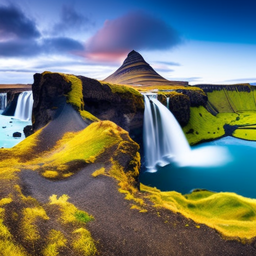
25. Skaftafell National Park
Skaftafell is a nature reserve located in Vatnajökull National Park, Iceland, known for its spectacular natural beauty, including glaciers, mountains, and waterfalls. The reserve offers a variety of hiking trails, including the popular hike to Svartifoss waterfall.
Skaftafell is home to waterfalls, glacier lagoons and black sand beaches. With over half a million visitors every year, the Skaftafell Nature Reserve is one of the most popular tourist attractions on Iceland’s south coast.
Skaftafell Ice Cave is a magnificent sight and a must-see destination. During winter, when rains wash out the top layers of the glacier, the cave is bathed in spectacular blue light. The cave is, however, open for visitors all year round.
Crystal Cave in Skatafell is another must-see tourist destination in Iceland. The Crystal Cave’s beautiful cavern-like interior is large and can be able to accommodate up to 100 people comfortably. Tours do not begin until the temperature is low enough for the ice caves to be stable and safe.
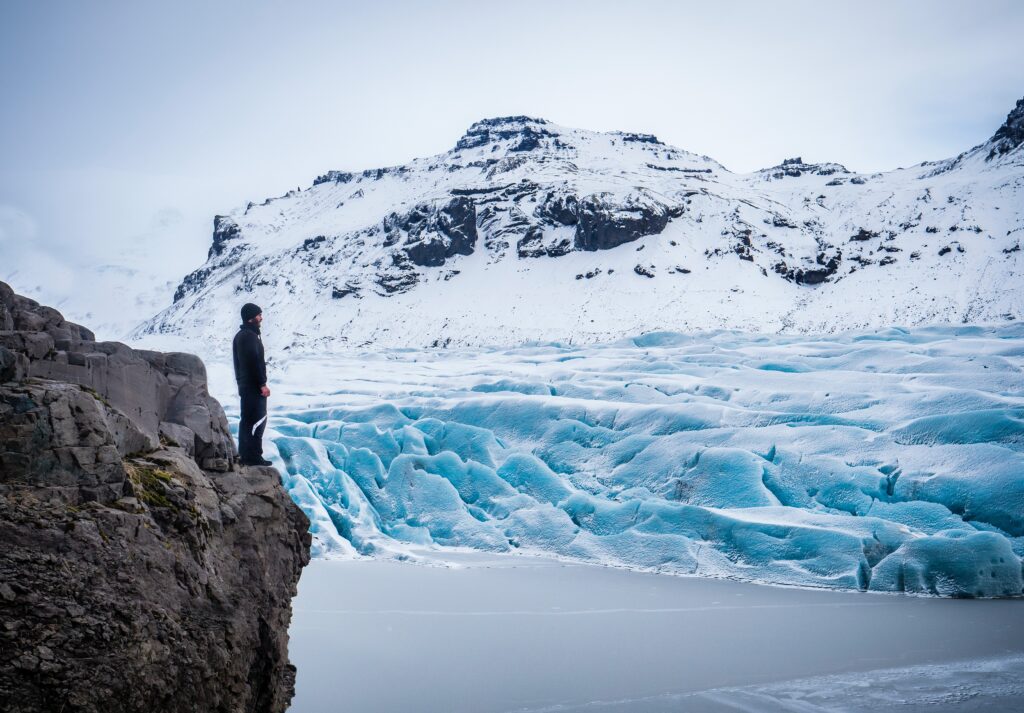
You should see Skaftafell if you want to experience the natural beauty of Iceland. The area is known for its stunning and unique beauty, and it is one of the most popular places for hiking.
24. Kirkjufellsfoss
Kirkjufellsfoss is a breathtaking waterfall located in West Iceland, near the town of Grundarfjörður. It is considered one of the most beautiful and iconic waterfalls in Iceland and is a popular destination for tourists and photographers alike. Kirkjufellsfoss is part of the Kirkjufells Mountain and falls from a height of approximately 46 meters into a clear and calm pool of water.
The waterfall is surrounded by a picturesque landscape of rolling hills, green meadows, and pristine lakes. It is particularly famous for its stunning view of the Northern Lights in the winter months, which can be seen from the nearby town of Grundarfjörður.
Visitors to Kirkjufellsfoss can hike to the waterfall along a well-marked trail that winds through the countryside. The trail is easy to follow and takes approximately 20 minutes to complete. Once visitors reach the waterfall, they can stand at the base and feel the full force of the water, or they can hike along the cliffs for a bird’s-eye view.
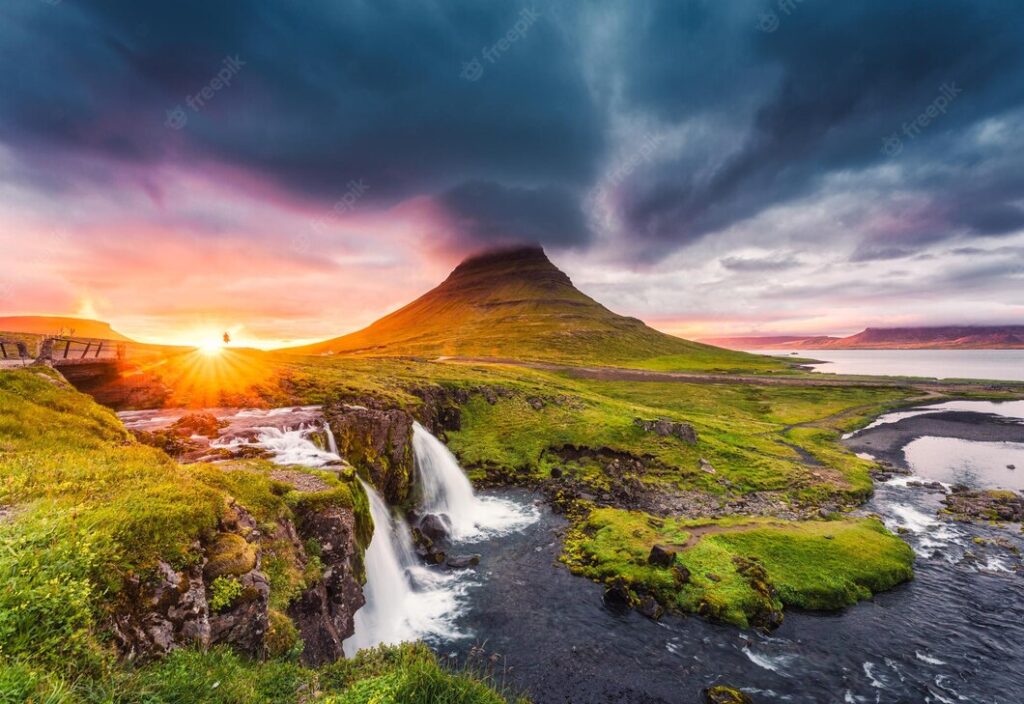
Kirkjufellsfoss is best visited in the summer months, when the weather is warmer and the sun shines bright. The waterfall is a popular destination for those who enjoy hiking and exploring the great outdoors, and it is easily accessible by road from the nearby town of Grundarfjörður.
In conclusion, Kirkjufellsfoss is a must-visit for anyone visiting Iceland. With its stunning beauty and iconic location, it is a symbol of Iceland’s rich history and heritage. So, pack your camera and head over to Kirkjufellsfoss to experience one of the most magnificent waterfalls in the world.
23. Hverir
Hverir Geothermal Area, also known as Hverir, Námafjall, Námaskarð or Hverarönd is a must-visit stop when traveling around North Iceland. It is a must-see place on Diamond Circle and one of the top attractions at the Lake Myvatn.
You should visit Hverir if you want to experience the natural beauty of Iceland. The area is known for its stunning and unique beauty, and it is one of the most popular places for hiking and for natural hot spring bathing in Myvatns Nature Baths.
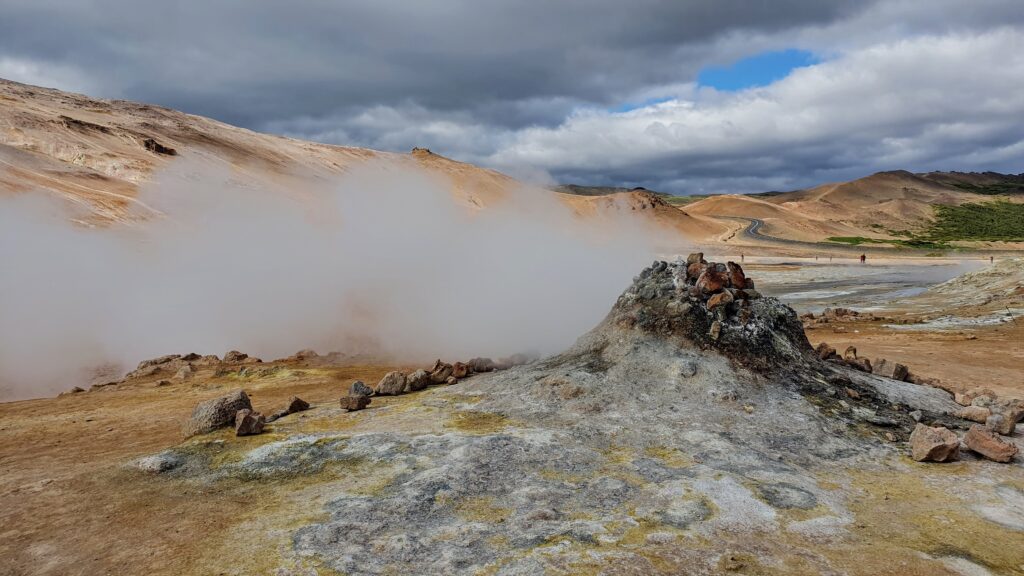
The Diamond Circle is a famed 260 kilometre (162 mile) sightseeing route in the northeast of Iceland, characterised by its sheer number of natural attractions, picturesque settlements and fantastic landscapes. The Diamond Circle has five key destinations, which include the historical and picturesque Goðafoss, the unearthly blue and green landscapes of Lake Mývatn nature paradise, the thundering Dettifoss waterfall, the horseshoe-shaped canyon of Ásbyrgi and the fishing town of Húsavík.
22. Landmannalaugar
Landmannalaugar is a must-see destination in Iceland. It is an area full of geothermal nature baths in the Highlands of Iceland. It is also famous for its notable surroundings full of spectacular rock formations, lava fields, and multicolored rhyolite mountains. Two of its most famous mountains are Blahnjukur (‘Blue Peak’) and Brennisteinsalda (‘Sulphur wave’)1.
Landmannalaugar marks the northern end of the Laugavegur, one of Iceland’s most popular hiking trails. This route connects Landmannalaugar and Þórsmörk, the ‘Valley of Thor’, ending at the beautiful Skógafoss waterfall2.
Throughout the summer, Landmannalaugar is one of the most popular places for hiking – either over one day or several – and for natural hot spring bathing. The area is known for its stunning and unique beauty, and it is one of the most popular places for hiking and for natural hot spring bathing3.
You should see Landmannalaugar if you want to experience the natural beauty of Iceland. The area is known for its stunning and unique beauty, and it is one of the most popular places for hiking and for natural hot spring bathing. The vibrant colors in the mountains and the unique hiking trails attract adventurous travelers all summer long.
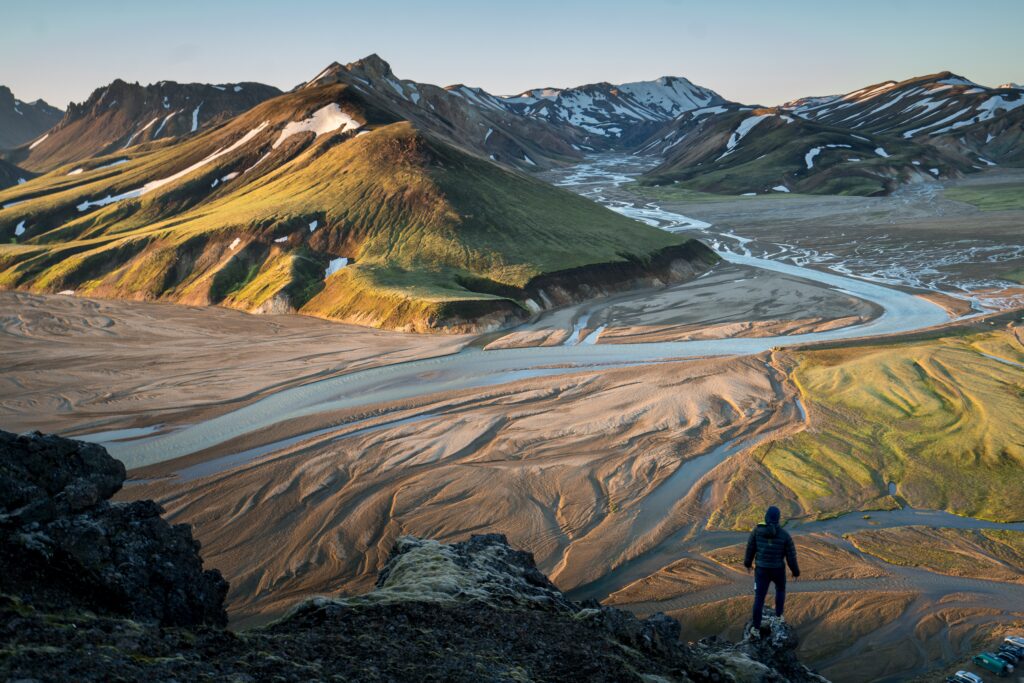
The best time to visit Landmannalaugar is from mid-June through early to mid-September. However, it is possible to visit Landmannalaugar year-round. The F-roads to Landmannalaugar open in mid-June and typically remain open until early September. However, this timing can change based on weather conditions. During the summer months, you’ll be able to admire the vibrant colors in the mountains and explore the area better. Landmannalaugar is usually covered by snow for 8 months of the year, which is why many of the hiking trails are only accessible in the summer months. In the summer, the temperature rises to around 10°C to 15°C (50°F – 59°F). Although the weather is slightly more comfortable in the summer, you can still expect strong winds on most days.
21. Þakgil: The Hidden Gem in the South of Iceland
Iceland is a country that is known for its stunning natural beauty. From the Northern Lights to the Blue Lagoon, there are countless attractions that draw tourists from all over the world. However, there is one spot in particular that is often overlooked but is an absolute must-see: Þakgil.
Located in the south of Iceland, Þakgil is a hidden gem that is often missed by tourists. This secluded spot is nestled in a narrow canyon and is surrounded by steep cliffs, making it feel like a secret hideaway. If you’re looking for a peaceful and serene spot to escape the crowds, then Þakgil is the perfect place to do so.
Getting to Þakgil can be a bit of an adventure in itself. The road leading to Þakgil is not paved, and it can be quite bumpy and rocky at times. However, once you arrive, you’ll quickly realize that the journey was well worth it.
One of the main attractions of Þakgil is the stunning waterfall that cascades down the cliff face. The waterfall is surrounded by lush green vegetation, and the sound of the water falling is incredibly peaceful. There is a small trail that leads to the base of the waterfall, where you can get up close and feel the mist on your face.
In addition to the waterfall, Þakgil is also home to a beautiful black sand beach. The beach is nestled in the canyon and is surrounded by towering cliffs. The black sand is made up of volcanic ash, and it’s a unique sight that you won’t find in many other places around the world. If you’re lucky, you might even spot a few seals sunbathing on the rocks.
One of the best things about Þakgil is that it’s a great spot for camping. There is a small campsite located in the canyon, and it’s a fantastic place to spend the night under the stars. The campsite is equipped with basic facilities, such as toilets and running water, but it’s important to note that there is no electricity or wifi.
If you’re feeling adventurous, there are also plenty of hiking trails that lead out from Þakgil. The trails take you through the stunning landscape of southern Iceland, and you’ll have the opportunity to see some truly breathtaking views.
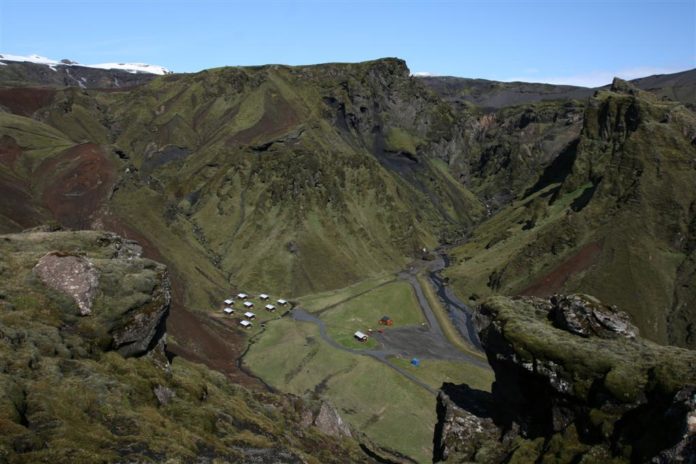
In conclusion, Þakgil is a hidden gem in the south of Iceland that is well worth a visit. If you’re looking for a peaceful and secluded spot to escape the crowds, then Þakgil is the perfect place to do so. With its stunning waterfall, black sand beach, and beautiful camping facilities, Þakgil is a must-see for any nature lover visiting Iceland. So the next time you’re planning a trip to Iceland, be sure to add Þakgil to your itinerary.
20. Gjáin – A Hidden Oasis in Þjórsárdalur
Iceland is a country of stunning landscapes and natural wonders, with countless waterfalls, glaciers, and geothermal pools to explore. However, some of the country’s most beautiful spots are hidden away, waiting to be discovered by adventurous travelers. One of these hidden gems is Gjáin, located in Þjórsárdalur valley in the south of Iceland.
Gjáin is a lush oasis tucked away in a narrow valley, surrounded by steep cliffs and colorful rock formations. It’s a place of rare natural beauty, with crystal clear streams, verdant greenery, and an array of wildflowers. The area is a haven for photographers, nature lovers, and anyone seeking a peaceful retreat from the bustle of modern life.
The valley is accessible by car, but it’s a bumpy and rocky road, so a 4×4 vehicle is recommended. The trailhead for the hike to Gjáin is located near the parking area. The hike is short and relatively easy, but it can be slippery and steep in places, so proper hiking boots are recommended.
As you descend into the valley, the first thing you’ll notice is the sound of water. The streams in Gjáin flow from a series of cascading waterfalls that tumble down the valley walls. The water is so clear and pure that you can see the rocks and pebbles on the bottom.
The valley is filled with all kinds of vegetation, from ferns and mosses to wildflowers and shrubs. The area is also home to a variety of bird species, including the elusive ptarmigan and the majestic gyrfalcon. The valley’s pristine environment provides a perfect habitat for these birds to thrive.
At the heart of Gjáin is a series of shallow pools and streams that are perfect for wading or even swimming. The water is cold, but refreshing on a hot summer day. There are plenty of rocks to sit on and take in the scenery, or you can simply lay back and soak in the sun.
The valley is also home to several historic buildings, including a small church and a farmhouse that dates back to the 19th century. These buildings provide a glimpse into Iceland’s rich cultural heritage and the way of life of its early settlers.

In conclusion, Gjáin is a hidden gem in Þjórsárdalur that is well worth a visit. With its stunning waterfalls, lush vegetation, and clear pools, Gjáin is a true oasis in the Icelandic landscape. It’s a place to disconnect from the modern world and connect with nature, a place to relax and rejuvenate. So if you’re planning a trip to Iceland, be sure to add Gjáin to your itinerary, and discover one of the country’s most beautiful and tranquil spots.
19. Goðafoss
Goðafoss, also known as the “Waterfall of the Gods,” is a stunning waterfall located in North East Iceland. It is one of the country’s most iconic waterfalls and is considered one of the most beautiful in the world. Goðafoss is approximately 12 meters high and 30 meters wide, and it is part of the Skjálfandafljót River.
The waterfall is said to have a rich history and was the site of a significant event in Icelandic history. According to legend, in the year 1000, a local chieftain, named Þorgeir Ljósvetningagoði, made a historic decision to adopt Christianity as the country’s official religion. To symbolize this momentous occasion, he threw his pagan gods into the waterfall, hence the name Goðafoss.
Visitors to the waterfall can walk up close to the cascading water and feel its power, or they can enjoy a bird’s-eye view from the nearby bridge. The waterfall is surrounded by a picturesque landscape, with rolling hills and lush greenery. The area is also home to a diverse array of wildlife, including birds and reindeer.
Goðafoss waterfall is best visited in the summer months, when the weather is warmer and the sun shines bright. The waterfall is easily accessible from the main road, and there is a large car park nearby. Visitors can also enjoy a picnic or take a walk in the surrounding area, making it a great place for families and people of all ages to visit.
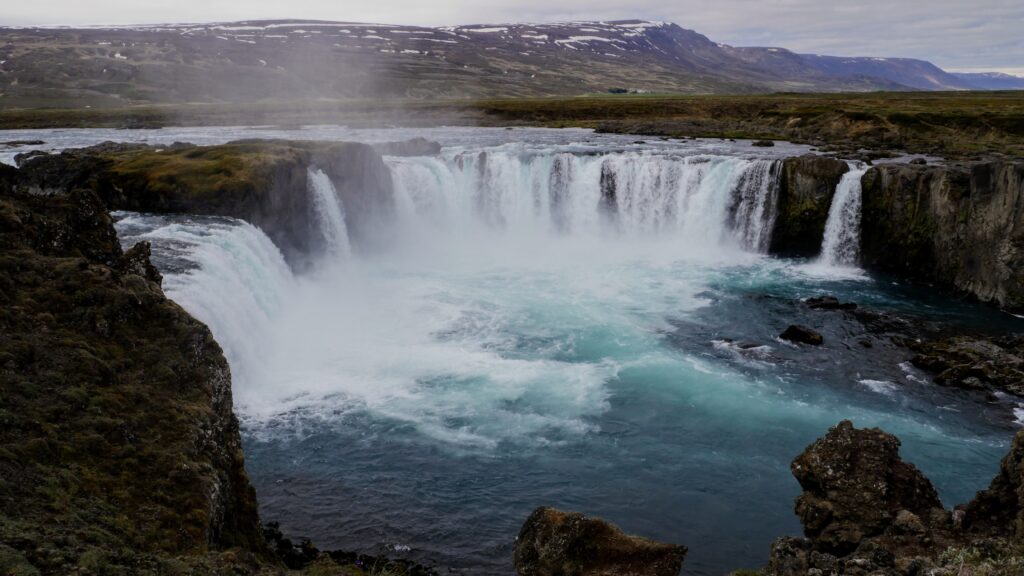
In conclusion, Goðafoss waterfall is a must-visit for anyone visiting Iceland. With its stunning beauty and rich history, it is an iconic symbol of the country and a testament to the power of nature. So, don’t miss out on the opportunity to experience one of the most magnificent waterfalls in the world.
18. Dyrhólaey
Dyrhólaey is a breathtaking natural wonder located on the south coast of Iceland. It’s a massive promontory that juts out into the Atlantic Ocean, offering stunning views of the surrounding landscape.
One of the main attractions of Dyrhólaey is the natural arch that has been carved out of the rock by the relentless force of the ocean waves. Visitors can walk through the arch and take in the spectacular views of the black sand beaches and towering cliffs that surround the promontory.
Another highlight of Dyrhólaey is the towering lighthouse that sits atop the promontory, offering stunning panoramic views of the surrounding area. The lighthouse dates back to 1910 and is still in use today, guiding ships safely through the treacherous waters of the North Atlantic.
Dyrhólaey is also home to a large colony of puffins, which can be seen nesting on the cliffs during the summer months. These adorable birds are a popular attraction for birdwatchers and nature lovers, and their presence adds to the charm and beauty of the area.
Visitors to Dyrhólaey can also explore the nearby beaches, including the famous Reynisfjara black sand beach. This stunning beach is known for its towering basalt columns and dramatic waves, making it a popular spot for photographers and adventurers.
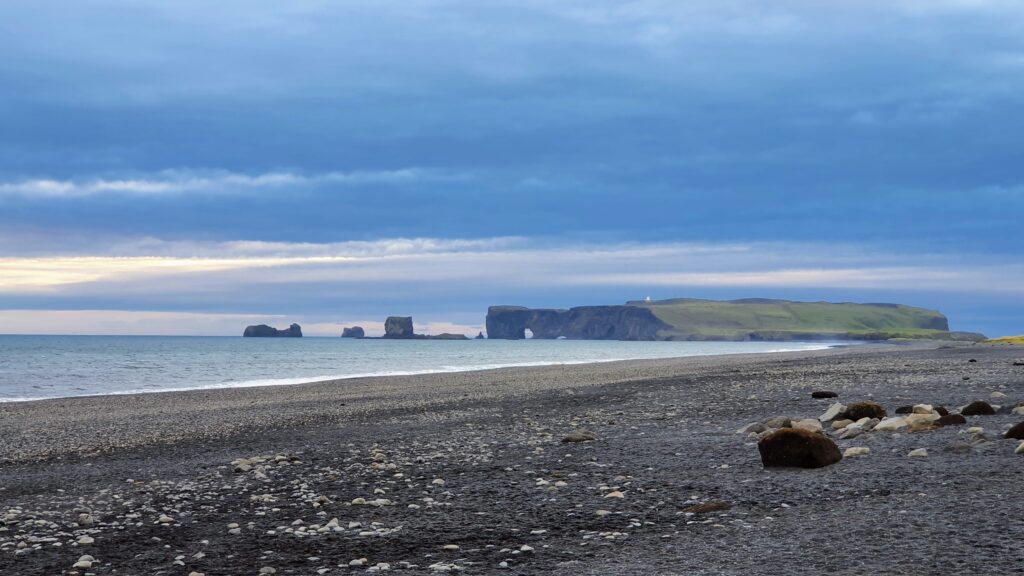
In conclusion, Dyrhólaey is a must-see destination for anyone visiting Iceland. With its natural arch, towering lighthouse, and puffin colonies, it’s a place of rare beauty and wonder. So if you’re planning a trip to Iceland, be sure to add Dyrhólaey to your itinerary and experience one of the country’s most breathtaking natural wonders.
17. Reykjadalur – Hike and Thermal Bathing
Reykjadalur is a geothermal valley located in South Iceland, known for its stunning natural beauty and hot springs. The valley offers a unique hiking experience that culminates in a relaxing soak in natural hot springs, making it a must-visit destination for anyone traveling to Iceland.
The hike to Reykjadalur is relatively easy, with a well-marked trail that takes visitors through a scenic landscape of mountains, rivers, and steam vents. Along the way, hikers can enjoy breathtaking views of the surrounding valleys and peaks.
As visitors reach the end of the trail, they will find themselves at the edge of a geothermal river, where they can take a dip in the natural hot springs. The water in the river is warm and soothing, and the mineral-rich water is said to have therapeutic properties.
Soaking in the hot springs is a unique and unforgettable experience, as visitors can enjoy the stunning scenery while relaxing in the warm water. The steam rising from the river and the surrounding mountains creates a surreal and tranquil atmosphere that is unlike anything else.
In addition to the hiking and hot springs, Reykjadalur also offers the opportunity to see some of Iceland’s native wildlife, including Icelandic horses and a variety of bird species.
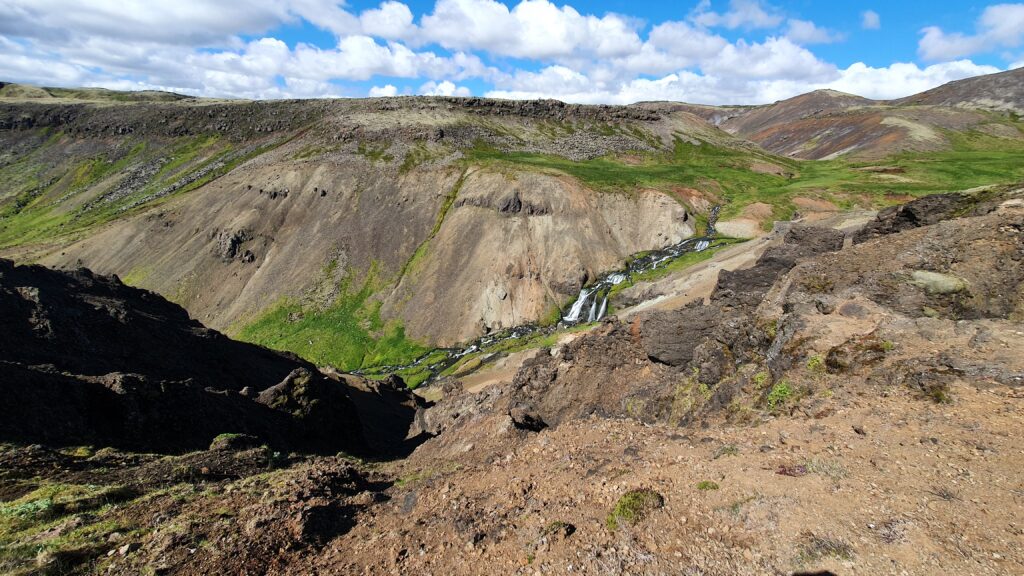
In conclusion, the Reykjadalur hike and thermal bathing experience is a must-do activity for anyone traveling to Iceland. It’s a unique opportunity to explore the country’s stunning natural landscape while also indulging in a relaxing soak in natural hot springs. So if you’re planning a trip to Iceland, be sure to add Reykjadalur to your itinerary and experience the magic of this geothermal valley for yourself.
16. Snæfellsjökull National Park – A Gem of Iceland’s West Coast
Snæfellsnes National Park is a stunning natural wonder located on the west coast of Iceland. The park covers an area of 170 square kilometers and is known for its diverse landscape, including mountains, glaciers, lava fields, and coastline.
One of the main attractions of Snæfellsnes National Park is the Snæfellsjökull glacier, which is the centerpiece of the park. The glacier is an active volcano and is said to have mystical and spiritual powers, which inspired Jules Verne’s novel “Journey to the Center of the Earth.”
Visitors can explore the glacier by hiking or snowmobiling, and enjoy stunning views of the surrounding landscape from the summit. The glacier is also a popular spot for stargazing, with clear night skies providing a perfect view of the stars and Northern Lights.
In addition to the glacier, Snæfellsnes National Park is home to a variety of other attractions, including black sand beaches, sea cliffs, and lava fields. Visitors can explore these areas by hiking or taking a guided tour, which will provide insight into the area’s history and natural wonders.
The park is also home to a variety of wildlife, including seabirds, seals, and whales. Visitors can take a boat tour to see these creatures up close, or simply enjoy the scenic beauty of the coastline.
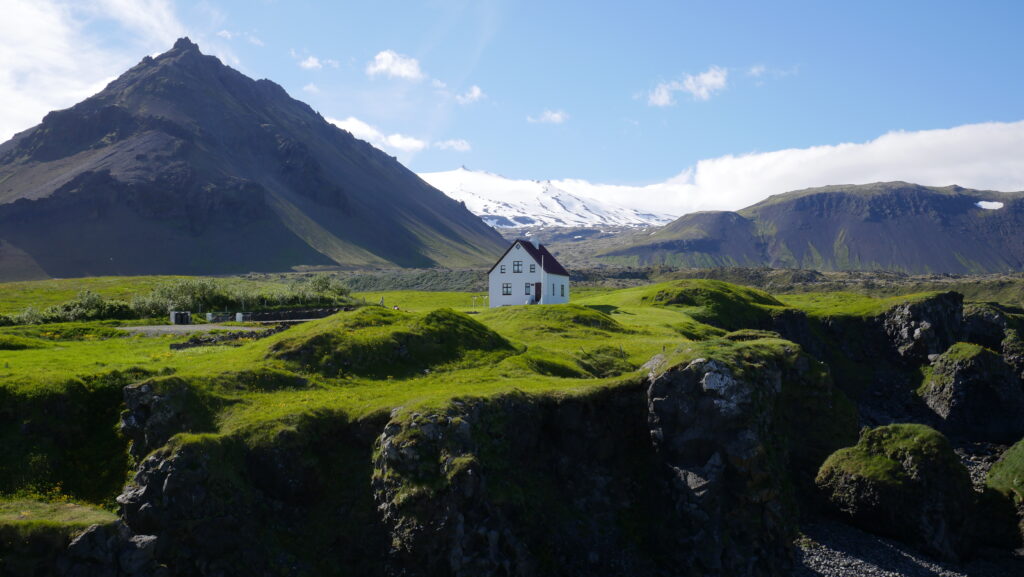
In conclusion, Snæfellsnes National Park is a must-see destination for anyone traveling to Iceland. Its diverse landscape, stunning glacier, and abundant wildlife make it a gem of Iceland’s west coast. So if you’re planning a trip to Iceland, be sure to add Snæfellsnes National Park to your itinerary and experience the magic of this natural wonder for yourself.
15. Dettifoss
Dettifoss is a magnificent waterfall located in the Vatnajökull National Park in North East Iceland. It is the most powerful waterfall in Europe, with an average water flow of 193 m³/s. Dettifoss is approximately 44 meters wide and falls from a height of 44 meters into the Jökulsárgljúfur Canyon.
The waterfall is surrounded by a rugged and remote landscape, with vast expanses of ice and snow in the winter months and lush green vegetation in the summer. The area is also known for its rich wildlife, including reindeer and Arctic foxes.
Visitors to Dettifoss can hike to the waterfall from either the east or west side of the canyon. The east side offers a closer view of the waterfall, but the west side provides a panoramic view of the waterfall and the surrounding landscape. Both trails are well marked and easy to follow, but visitors should be prepared for rough terrain and a challenging hike.
Dettifoss is best visited in the summer months, when the weather is warmer and the sun shines bright. However, it is also a popular destination for those who enjoy winter sports, such as cross-country skiing and snowshoeing. The waterfall is easily accessible by road and there is a large car park nearby.
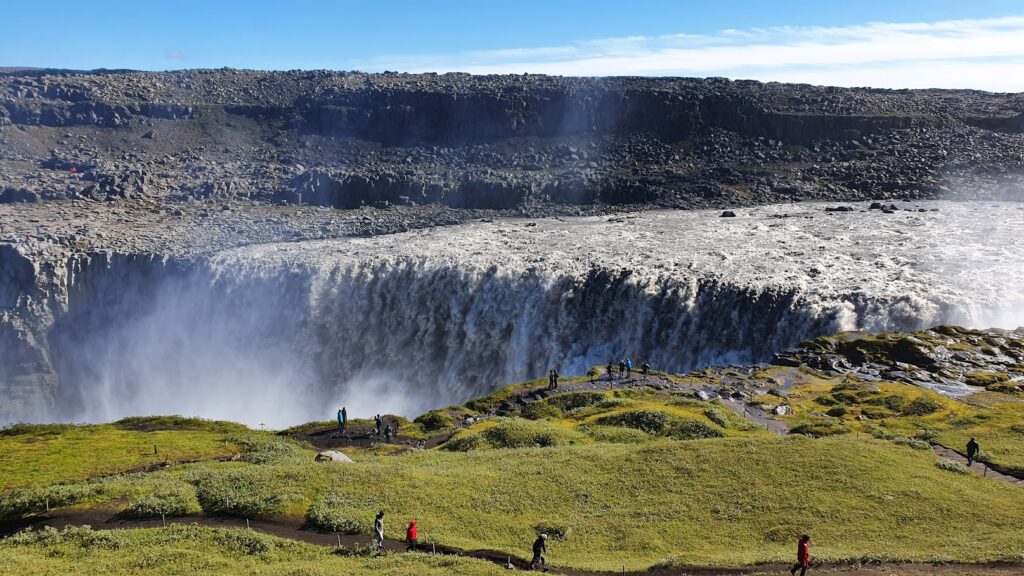
In conclusion, Dettifoss is a must-visit for anyone visiting Iceland. With its stunning beauty and incredible power, it is a testament to the raw beauty of nature and a symbol of Iceland’s rich history and heritage. So, pack your camera and head over to Dettifoss to experience one of the most magnificent waterfalls in the world.
14. Fjarðrárgljúfur – A Hidden Gem in South Iceland
Fjaðrárgljúfur is a stunning canyon located in the south of Iceland, near the town of Kirkjubæjarklaustur. The canyon is approximately 2 kilometers long and up to 100 meters deep, with crystal-clear waters running through it.
The canyon was formed by the Fjaðrá river, which eroded the rock over millions of years, creating the unique landscape that we see today. The canyon is surrounded by steep cliffs and lush vegetation, providing a stunning contrast between the rugged rock and vibrant greenery.
Visitors to Fjaðrárgljúfur can hike along the canyon rim and enjoy breathtaking views of the canyon and surrounding landscape. There are also several hiking trails that lead down into the canyon, allowing visitors to explore the river and its waterfalls up close.
One of the most impressive features of Fjaðrárgljúfur is the numerous waterfalls that can be found throughout the canyon. These waterfalls range in size from small cascades to towering falls, and they create a stunning natural spectacle that is not to be missed.
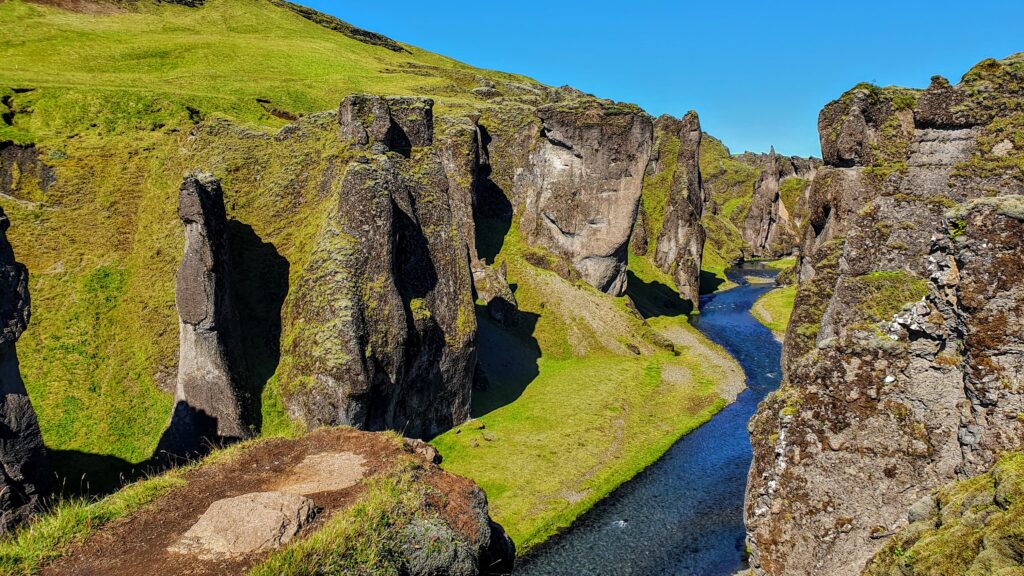
Fjaðrárgljúfur is a hidden gem in South Iceland, and it’s a must-visit destination for anyone traveling to the area. The canyon’s unique beauty and peaceful atmosphere provide a welcome escape from the hustle and bustle of modern life. So if you’re looking for a beautiful and tranquil spot to visit in Iceland, be sure to add Fjaðrárgljúfur to your itinerary.
13. Fagradalsfjall – Newest Eruption Beauty
Fagradalsfjall Volcano is Iceland’s newest eruption and is located on the Reykjanes Peninsula, about 30 minutes drive from Reykjavik. The volcano began erupting in March 2021, attracting visitors from all over the world who are eager to witness the natural beauty of this incredible phenomenon.
The eruption is located in a remote area and can only be accessed by hiking for approximately 1.5 hours. The trail to the volcano is easy to follow and provides stunning views of the surrounding landscape, including lava fields and mountains.
Once you reach the volcano, you’ll be greeted by a surreal landscape of molten lava flowing down the hillside. The colors of the lava range from bright red to black, creating a stunning contrast with the green moss-covered ground. Visitors can get up close to the lava and feel its heat, making for an unforgettable experience.
Fagradalsfjall Volcano is also a popular spot for photographers and videographers, who capture the beauty and power of the eruption in stunning detail. The spectacle is even more impressive at night, with the glowing lava providing an eerie and beautiful backdrop to the dark sky.
Although the eruption is currently ongoing, it’s important to note that it’s a natural phenomenon and can be unpredictable. Visitors should take precautions, follow safety guidelines, and check for updates before heading out to the volcano.
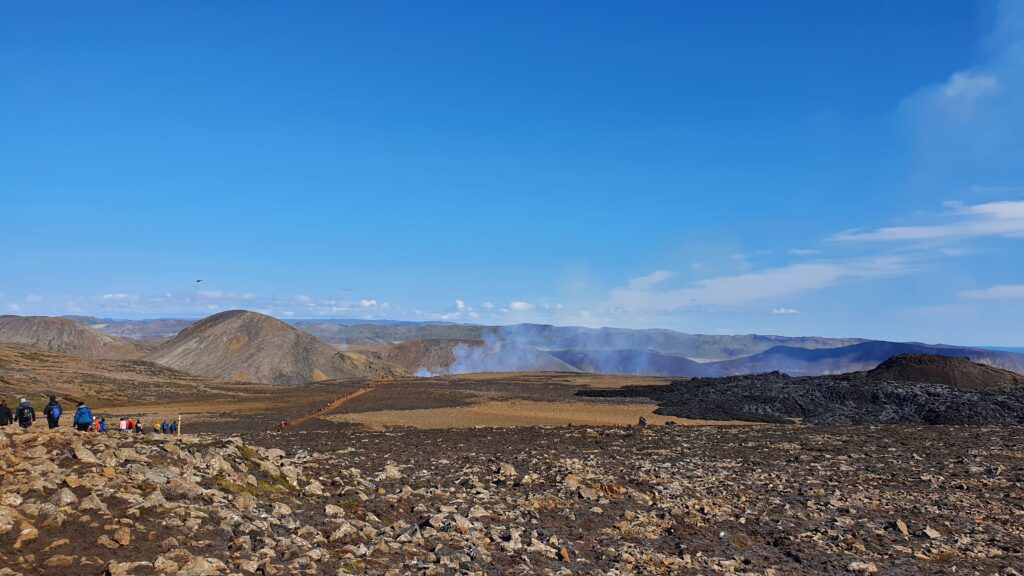
In conclusion, Fagradalsfjall Volcano is a must-visit destination for anyone traveling to Iceland. The eruption is a testament to the natural beauty and power of Iceland’s unique landscape, and witnessing it firsthand is an unforgettable experience. So if you’re planning a trip to Iceland, make sure to add Fagradalsfjall Volcano to your itinerary and experience the wonder of this amazing phenomenon for yourself.
12. Þórsmörk – A Hiker’s Paradise
Þórsmörk, also known as Thorsmork, is a stunning valley located in the south of Iceland, nestled between three glaciers: Eyjafjallajökull, Mýrdalsjökull, and Tindfjallajökull. The valley is known for its rugged and dramatic landscape, with towering mountains, roaring rivers, and lush vegetation.
Þórsmörk is a hiker’s paradise, with numerous trails leading through the valley and surrounding mountains. The most popular hike is the Fimmvörðuháls trail, which takes hikers on a challenging but rewarding journey through volcanic terrain, past waterfalls, and over glaciers. The trail ends at the iconic Skógarfoss waterfall, providing a stunning finale to the hike.
In addition to hiking, Þórsmörk is also a popular destination for camping and wildlife watching. The valley is home to a variety of animals, including reindeer, arctic foxes, and numerous bird species. Visitors can also soak in the hot springs or relax by the campfire after a long day of exploring.
One of the most unique features of Þórsmörk is its location, which makes it one of the few places in Iceland that can only be accessed by a 4×4 vehicle or hiking. This remoteness adds to the allure of the valley and provides visitors with a sense of isolation and tranquility.
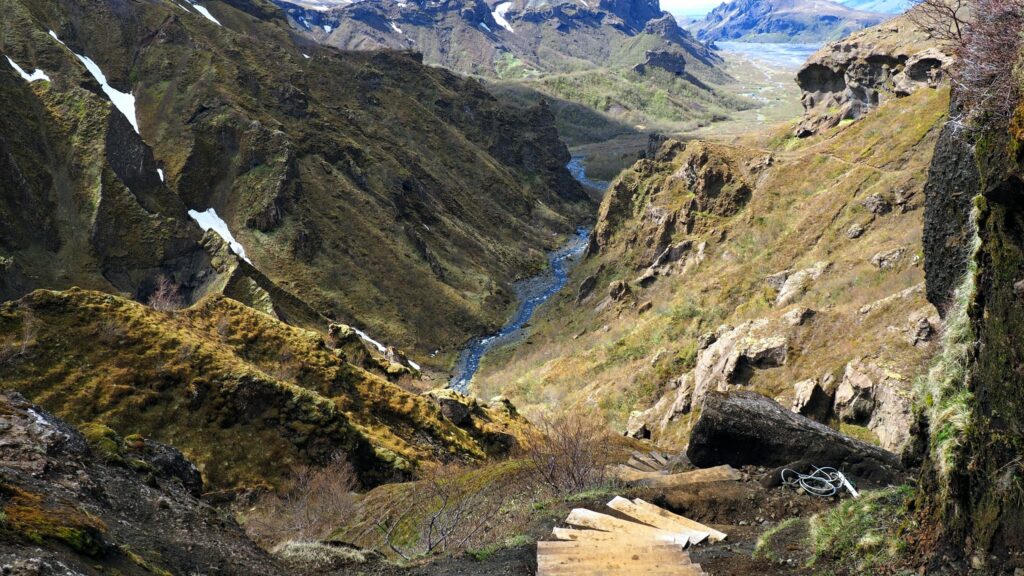
Overall, Þórsmörk is a must-visit destination for anyone traveling to Iceland, especially those who enjoy hiking and outdoor adventures. The valley’s rugged beauty and unique location make it a truly special place that will leave a lasting impression on anyone who visits. So if you’re planning a trip to Iceland, make sure to add Þórsmörk to your itinerary and experience the wonders of this amazing valley for yourself.
11. Aldeyjarfoss – A Hidden Gem
Iceland is a country that is well-known for its stunning landscapes, including glaciers, volcanoes, and waterfalls. One waterfall that stands out from the rest is Aldeyjarfoss, a hidden gem located in the north-central part of Iceland.
Aldeyjarfoss is a waterfall that cascades down from a height of 20 meters into a rugged, rocky canyon. The water flows from the Skjálfandafljót River, which is one of the longest rivers in Iceland. The contrast between the dark volcanic rocks and the white foamy water creates a mesmerizing sight that is both beautiful and eerie.
The name Aldeyjarfoss means “the waterfall on the river island” in Icelandic. It got its name because it is located on an island in the middle of the Skjálfandafljót River. To reach the waterfall, you must take a short hike through a lava field, which can be quite challenging, but the payoff is definitely worth it.
Aldeyjarfoss is not as well-known as some of the other waterfalls in Iceland, such as Gullfoss or Seljalandsfoss. However, it is just as beautiful and offers a more secluded and peaceful experience. The area around the waterfall is relatively untouched and offers a unique opportunity to experience Iceland’s raw, untouched beauty.
If you plan to visit Aldeyjarfoss, it is recommended to visit during the summer months when the weather is milder, and the hiking conditions are better. However, if you’re looking for a more dramatic and snowy landscape, visiting during the winter can be equally as beautiful.
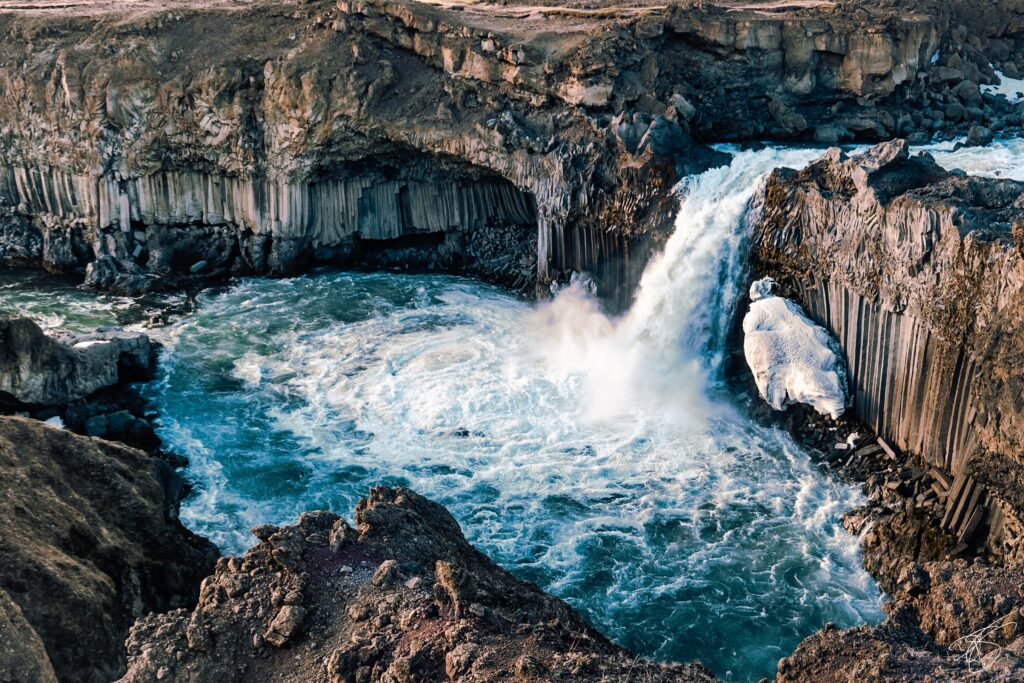
In conclusion, Aldeyjarfoss is a hidden gem that should not be missed by anyone visiting Iceland. It is a beautiful and serene place that offers a unique and unforgettable experience. If you’re looking for an adventure off the beaten path, Aldeyjarfoss is the perfect destination.
Aldeyjarfoss waterfall is best visited in the summer months, when the weather is warmer and the sun shines bright. The waterfall is one of the many hidden treasures in Iceland and is definitely worth visiting if you’re planning a trip to this beautiful country. So, pack your camera and head over to Aldeyjarfoss to experience one of the most magnificent waterfalls in Iceland.
10. Kvernufoss – The Secret Waterfall
South Iceland is known for its stunning landscapes, including glaciers, volcanoes, and waterfalls. One waterfall that often gets overlooked is Kvernufoss, a hidden gem located near the popular Skogafoss waterfall.
Kvernufoss is a 30-meter waterfall that flows from the Kverná River, which is a tributary of the larger Markarfljót River. The waterfall is surrounded by towering cliffs and lush vegetation, making it a secluded and peaceful oasis.
To reach Kvernufoss, you must take a short hike through a beautiful canyon. The trail can be steep and rocky in some parts, but the scenery is breathtaking, and the hike is well worth the effort. Once you reach the waterfall, you’ll be rewarded with a stunning view of the cascading water and the surrounding natural beauty.
Kvernufoss is not as well-known as some of the other waterfalls in South Iceland, but it offers a unique and more intimate experience. The waterfall is far less crowded than Skogafoss, and the peaceful surroundings allow for a deeper connection with nature.
In addition to the waterfall, the surrounding area is home to some of Iceland’s best hiking trails. You can explore the canyon and the nearby river, or take a longer hike to explore the surrounding hills and mountains.
If you plan to visit Kvernufoss, it is recommended to wear sturdy hiking shoes and bring a waterproof jacket, as the mist from the waterfall can make the area quite wet. It is also a good idea to bring a camera to capture the stunning scenery.
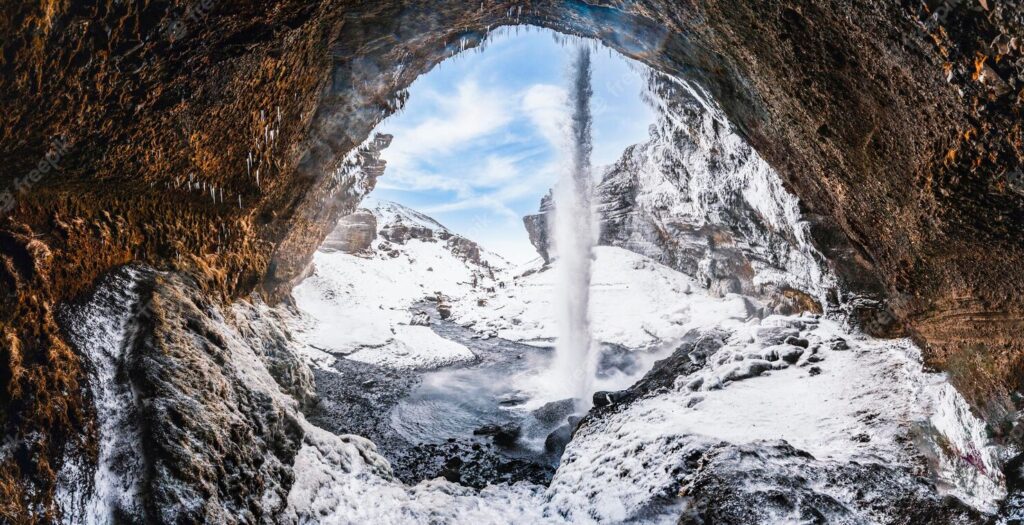
In conclusion, Kvernufoss is a hidden gem that should not be missed by anyone visiting South Iceland. It offers a unique and more intimate experience compared to some of the more popular waterfalls in the area. If you’re looking for a peaceful and scenic adventure, Kvernufoss is the perfect destination.
9. Glúfrabúi – The Hidden Waterfall
South Iceland is home to some of the world’s most stunning waterfalls, but one hidden gem that often goes overlooked is Gljúfrabúi. Located near the popular Seljalandsfoss waterfall, Gljúfrabúi is a hidden oasis that offers a unique and peaceful experience for visitors.
Gljúfrabúi is a 40-meter waterfall that flows from the Hamragarðafoss River, which is a tributary of the larger Seljalandsá River. The waterfall is hidden in a narrow canyon, surrounded by towering cliffs and lush vegetation. To reach the waterfall, visitors must wade through a small stream and enter a narrow crevice in the rock, where the waterfall is hidden from view.
Once inside the crevice, visitors are greeted with a stunning view of the cascading water and the surrounding natural beauty. The mist from the waterfall creates a mystical atmosphere, making visitors feel like they are in a secret fairy tale world.
To fully enjoy the experience, it is recommended to wear waterproof clothing and sturdy shoes, as the rocks can be slippery and wet. However, the unique perspective and peaceful surroundings make it a worthwhile adventure.
In addition to the waterfall, the surrounding area is home to some of Iceland’s best hiking trails. Visitors can explore the nearby canyon and river, or take a longer hike to explore the surrounding hills and mountains.
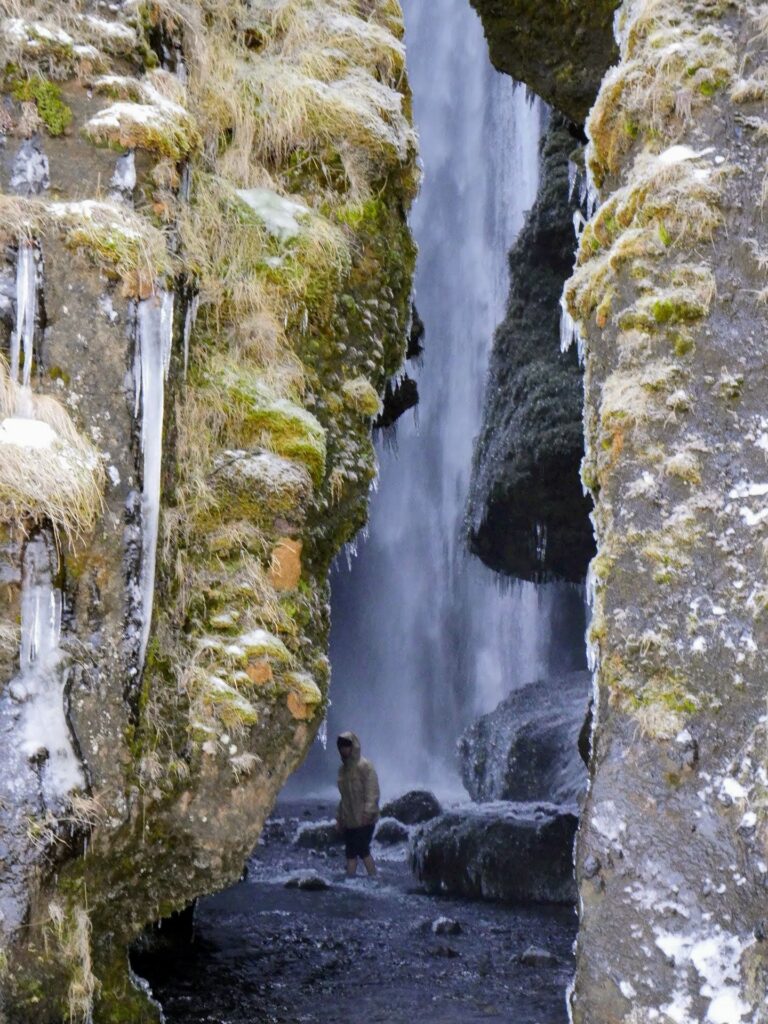
Gljúfrabúi may not be as well-known as some of the other waterfalls in South Iceland, but it offers a unique and unforgettable experience. Its hidden location and peaceful surroundings allow for a deeper connection with nature and a sense of adventure.
In conclusion, Gljúfrabúi is a hidden gem that should not be missed by anyone visiting South Iceland. Its secluded location and unique perspective make it a memorable and peaceful experience for visitors. If you’re looking for a peaceful and adventurous escape, Gljúfrabúi is the perfect destination.
8. Háifoss
Háifoss is a waterfall located in South Iceland in the Fossá River. It is one of the tallest waterfalls in Iceland, with a height of 122 meters (400 ft) and is considered one of the most spectacular waterfalls in the country. The waterfall is located in a remote and rugged valley, surrounded by towering cliffs and lush vegetation.
Visitors can reach the waterfall via a challenging hike through the valley, which takes around 2-3 hours each way. The trail is steep and rocky in some parts and requires crossing a river, so it’s suitable for experienced hikers only, but there is also car park on the top on opposite side. The view of the waterfall from the top is breathtaking, and the hike itself is a great way to experience the natural beauty of Iceland. It’s also a good idea to check the weather forecast and wear suitable footwear as the trail can be slippery when wet. The waterfall is particularly beautiful during summer when the water is at its fullest.
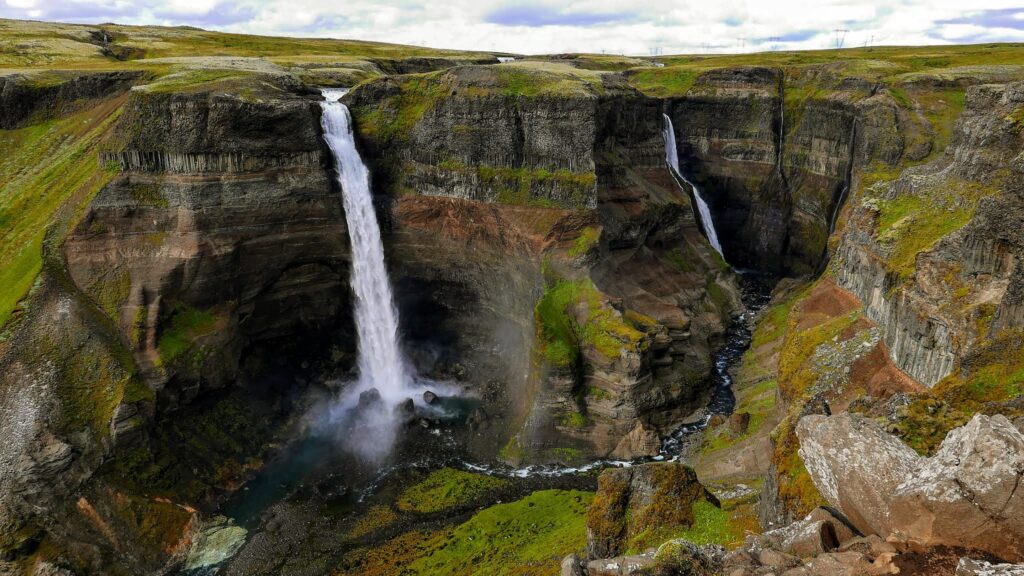
7. Jökulsárlón – A Natural Wonder
Jökulsárlón is a stunning glacial lagoon located in South Iceland. The lagoon is situated at the edge of Vatnajökull National Park, and it’s easily one of the most beautiful and awe-inspiring natural wonders in Iceland.
The lagoon is formed by the melting of Breiðamerkurjökull glacier, which is part of the Vatnajökull glacier, the largest ice cap in Europe. The melting ice creates a pool of crystal-clear water, which is filled with icebergs of various sizes and shapes. The icebergs are constantly moving and changing, making the view of the lagoon a dynamic and ever-changing spectacle.
Visitors to Jökulsárlón can take a boat tour to explore the lagoon and get up close to the icebergs. The tour guides provide fascinating information about the glacial environment and the formation of the icebergs, making it an educational experience as well as a visually stunning one.
In addition to the boat tour, visitors can also take a walk along the black sand beach adjacent to the lagoon, known as Diamond Beach. Here, the icebergs that have broken off from the glacier are carried by the currents and washed up on the shore, creating a surreal and otherworldly landscape.
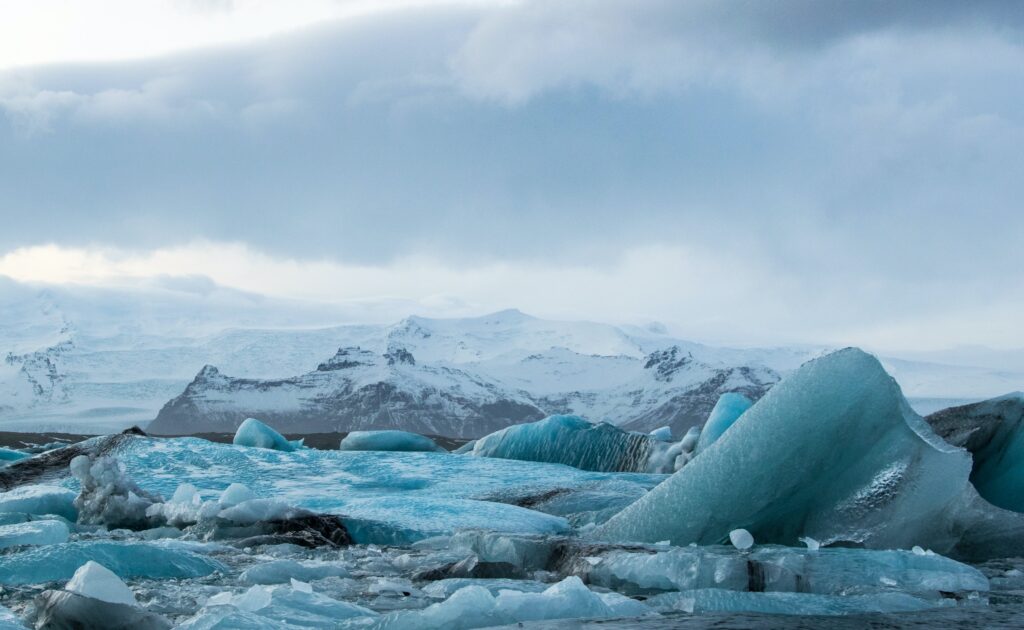
Jökulsárlón is truly a unique and magical place that is a must-see for anyone visiting Iceland. It’s a reminder of the incredible power and beauty of nature and a testament to the importance of preserving our planet’s natural wonders for future generations to enjoy.
6. Skógafoss
Skogarfoss is a waterfall located in South Iceland, near the town of Skógar. This waterfall is one of the most famous and visited natural wonders in Iceland, attracting thousands of tourists every year. Skogarfoss is a single-tiered waterfall with a height of 60 meters and a width of 25 meters.
The waterfall is fed by the Skógá river, which originates from the nearby Eyjafjallajökull glacier. The water cascades down the cliff in a powerful and impressive display of water and nature. On sunny days, rainbows can often be seen arching over the waterfall, adding to its beauty.
Visitors to Skogarfoss can walk along a series of pathways and platforms that offer breathtaking views of the waterfall from different angles. There is also a staircase that leads to the top of the waterfall, allowing visitors to get an up-close view of the powerful water flow.
In addition to its natural beauty, Skogarfoss is also historically significant as a location for one of Iceland’s earliest settlers, Þrasi Þórólfsson. According to legend, Þrasi buried a treasure chest in a cave behind the waterfall, adding to its allure for visitors.
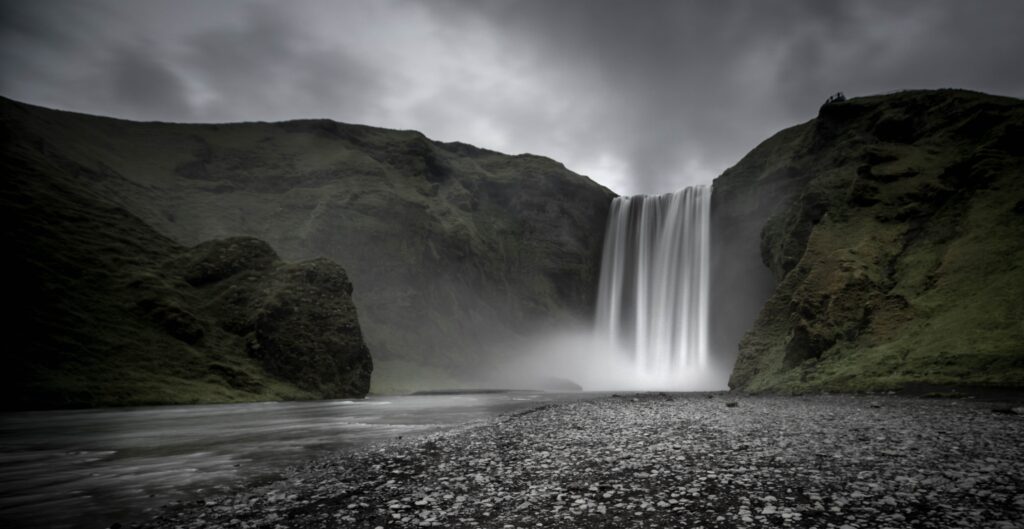
In conclusion, Skogarfoss is a stunning waterfall that showcases the raw power and beauty of nature in Iceland. With its historical significance and breathtaking views, it is a must-visit destination for anyone traveling to Iceland.
5. Reynisfjara
Reynisfjara is a stunning black sand beach located in South Iceland, just a short drive from the town of Vik. Known for its dramatic landscape and unique geology, Reynisfjara is one of the most popular tourist destinations in Iceland.
The beach is framed by towering basalt cliffs that have been carved into incredible formations by the force of the ocean. These formations, known as Reynisdrangar, rise up from the sea and create a surreal and mystical atmosphere. According to local legend, the Reynisdrangar are actually trolls who were turned to stone by the rising sun.
In addition to the stunning cliffs, Reynisfjara is also famous for its black sand. The sand is formed by the erosion of basalt rock, which creates fine particles that give the beach its distinctive color. The contrast between the black sand and the white surf is truly striking, and it makes for a perfect backdrop for photography.
One of the unique features of Reynisfjara is the basalt columns that can be found at the back of the beach. These columns, formed by the slow cooling of lava, create a natural cathedral-like structure that is truly awe-inspiring. Visitors can walk among the columns and marvel at the intricate geometric shapes.
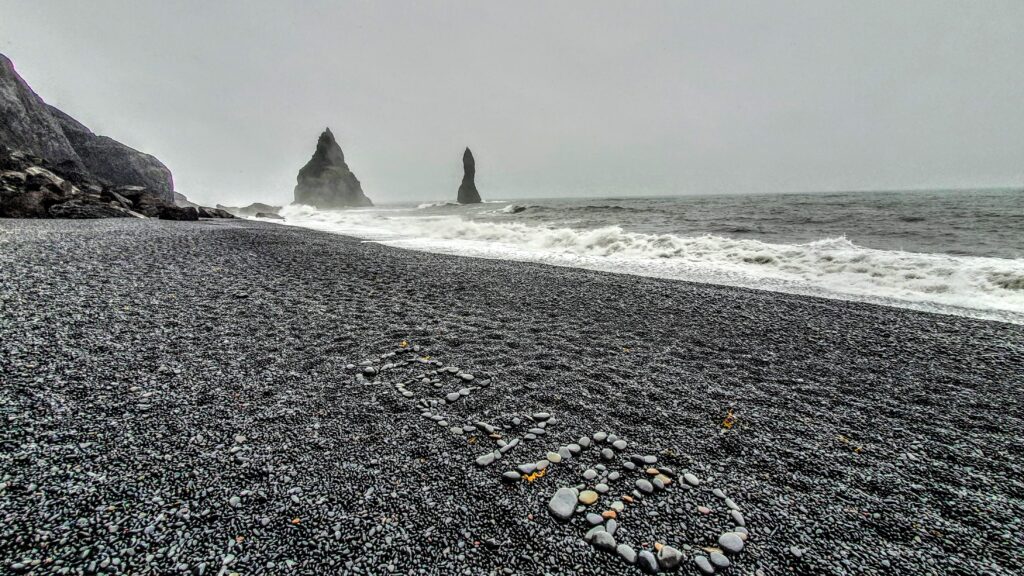
However, it’s important to note that Reynisfjara can be a dangerous place. The waves at the beach are notoriously strong, and the currents are unpredictable. Visitors are advised to keep a safe distance from the water’s edge and to be aware of their surroundings at all times.
Despite its dangers, Reynisfjara remains a must-see destination for anyone visiting Iceland. Its raw beauty and unique geology make it a one-of-a-kind experience that is sure to leave a lasting impression.
4. Thingvellir National Park
Thingvellir National Park, located in southwestern Iceland, is a must-see destination for those visiting the country. This unique park has a rich history, stunning natural beauty, and geological significance, making it a popular stop on the famous Golden Circle tour.
Thingvellir is known for being the location of the world’s first democratically elected parliament, the Althing, which was established in 930 AD and continued to meet here until 1798. Visitors can explore the ruins of the ancient parliament building and learn about Iceland’s unique history and cultural heritage.
In addition to its historical significance, Thingvellir is also a geological wonder. The park is located on the Mid-Atlantic Ridge, the boundary between the North American and Eurasian tectonic plates. This geological feature can be seen in the dramatic cliffs and fissures that run through the park, and visitors can walk between the two continents on the tectonic plate boundary.
Another must-see attraction in Thingvellir is the clear and blue waters of Lake Thingvallavatn, Iceland’s largest lake. The lake offers stunning views and opportunities for fishing, swimming, and boating. Hiking trails in the park also lead visitors to beautiful waterfalls, hot springs, and other natural wonders.
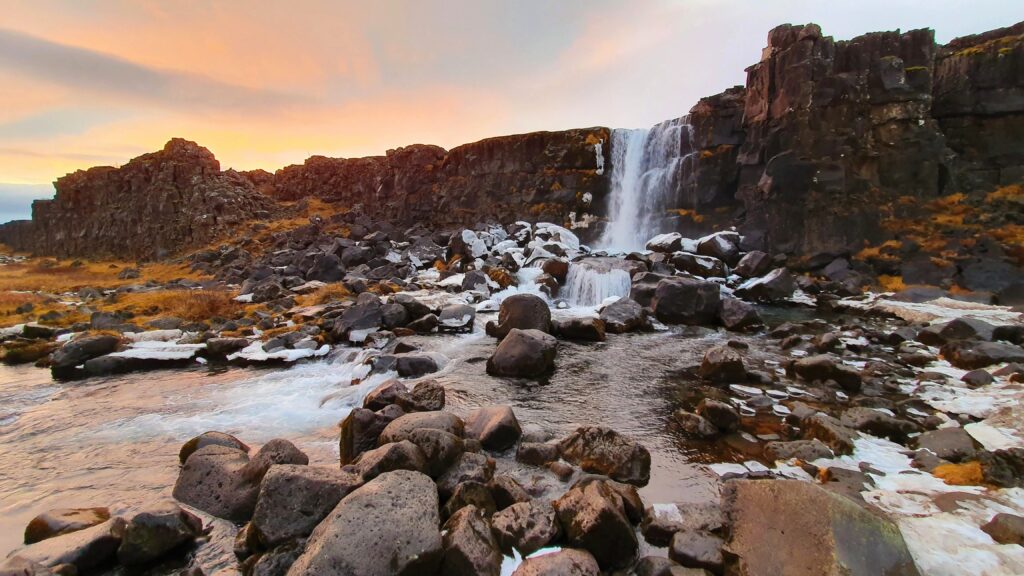
In conclusion, Thingvellir National Park offers a unique combination of history, natural beauty, and geological significance, making it a must-see destination for those visiting Iceland. Whether you’re interested in exploring the country’s cultural heritage, admiring its stunning landscapes, or learning about its geological wonders, Thingvellir has something for everyone.
3. Gullfoss
Gullfoss is a must-see destination in Iceland for its spectacular beauty and natural wonder. The waterfall is located in the canyon of the Hvítá river in the Golden Circle region of Iceland and is one of the country’s most famous tourist attractions.
The waterfall is over 100 feet tall and has two stages, creating a powerful and mesmerizing sight as the water cascades down the rock formations. On sunny days, visitors can observe a rainbow appearing over the falls, adding to its beauty.
In addition to its stunning appearance, Gullfoss also holds a significant historical and cultural value. In the early 20th century, the waterfall was in danger of being dammed and harnessed for hydroelectric power. Thanks to the efforts of Sigríður Tómasdóttir, a local woman who fought to preserve the waterfall, it was protected and remains a natural and untouched wonder.
Visitors can take a short hike to the viewpoint, which offers a panoramic view of the waterfall and the surrounding landscape. It is a breathtaking experience that is not to be missed by anyone visiting Iceland.
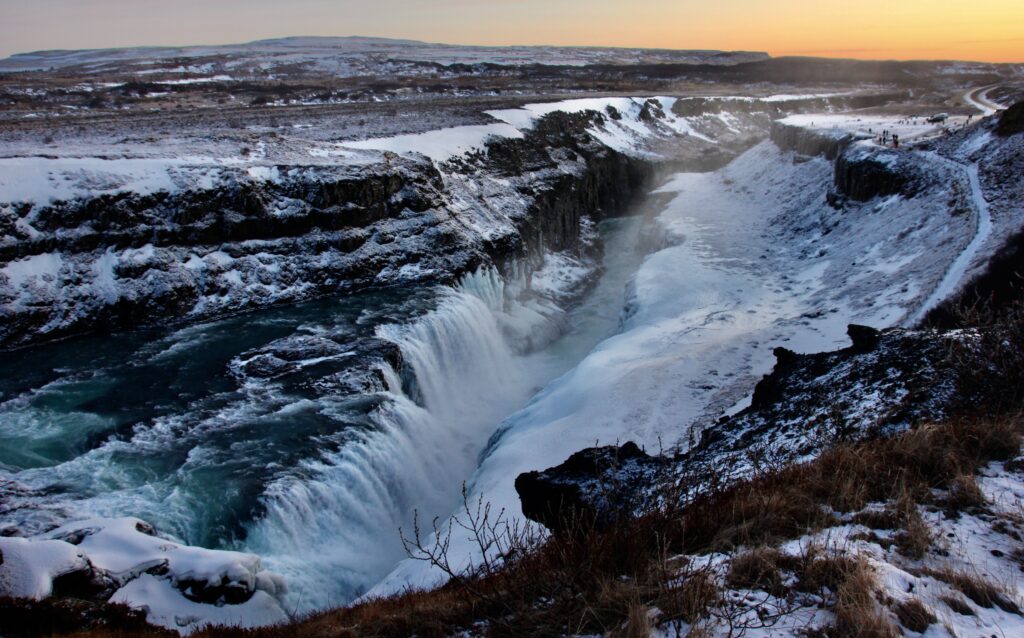
Overall, Gullfoss is a must-see destination in Iceland for its stunning beauty, cultural significance, and unique natural wonder. It is a must-visit for anyone who wants to experience the raw beauty of Iceland’s natural landscapes.
2. Seljalandsfoss – The Iconic Waterfall
South Iceland is home to some of the world’s most breathtaking waterfalls, and Seljalandsfoss is undoubtedly one of the most iconic. Located along the South Coast’s popular Golden Circle route, Seljalandsfoss is a must-see destination for anyone visiting Iceland.
The waterfall is located on the Seljalands River, which originates from the famous Eyjafjallajökull volcano. The water cascades down from a height of 60 meters, creating a stunning curtain of water that can be seen from miles away. What makes Seljalandsfoss truly unique is that visitors can walk behind the waterfall, providing a one-of-a-kind perspective and photo opportunity.
The walk behind the waterfall can be slippery and wet, so it is recommended to wear appropriate footwear and a waterproof jacket. However, the experience is well worth the effort, as visitors can feel the power and mist of the waterfall up close.
In addition to the waterfall, the surrounding area is home to some of Iceland’s most stunning natural beauty. Visitors can explore the nearby cliffs and caves or take a hike to the nearby Gljúfrabúi waterfall, which is hidden in a nearby canyon.
Seljalandsfoss is also one of the most accessible waterfalls in Iceland, as it is located just a short drive from Reykjavik. Visitors can easily add it to their itinerary while exploring other popular attractions along the South Coast, such as the black sand beaches of Vik or the nearby Skógafoss waterfall.
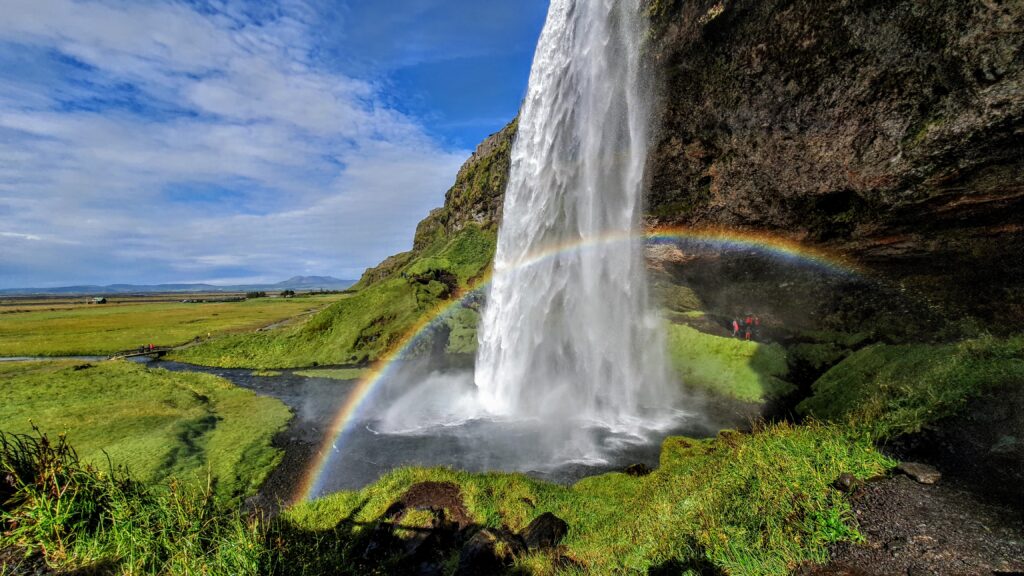
In conclusion, Seljalandsfoss is a must-see destination for anyone visiting South Iceland. Its iconic beauty and unique perspective make it a popular and unforgettable attraction. Whether you’re a seasoned traveler or a first-time visitor, Seljalandsfoss is sure to leave you in awe of Iceland’s stunning natural beauty.
1. Blue Lagoon
Blue Lagoon is one of the most popular destinations in Iceland, and it’s not hard to see why. This stunning geothermal spa, located in the Reykjanes peninsula, has become synonymous with Iceland, attracting millions of visitors every year.
The lagoon’s bright blue waters, set against the backdrop of black lava fields, create a stunning contrast that is truly mesmerizing. The water is heated by the geothermal activity in the area, and it’s rich in minerals, including silica and sulfur, which are believed to have numerous health benefits.
Visitors to Blue Lagoon can enjoy a range of activities, including soaking in the warm waters, relaxing with a massage or spa treatment, or dining in one of the many restaurants on-site. The lagoon also offers a range of products, including skincare and bathing products, which are made with natural and sustainable ingredients.
Despite its popularity, Blue Lagoon remains committed to sustainability and the environment. The spa uses geothermal energy to power its facilities, and the water used in the lagoon is carefully monitored and recycled to minimize its impact on the environment. The lagoon also works closely with local organizations to protect the surrounding natural environment.

While some visitors may find the crowds at Blue Lagoon to be overwhelming, the experience is truly unforgettable. Its stunning natural beauty, health benefits, and commitment to sustainability make it a must-visit destination in Iceland. For those seeking a truly unique and rejuvenating experience, Blue Lagoon is an excellent choice.
